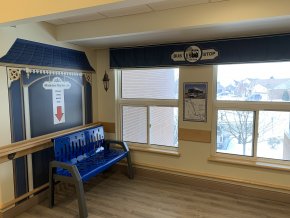Behavioural Support Transitional Unit enhances dementia care at Extendicare McGarrell Place
Dementia is a leading cause for long-term care placement. At Extendicare McGarrell Place in London, Ontario, the Behavioural Support Transitional Unit (BSTU) is making strides to transform dementia care. This person-centered, holistic program tailors assessment and treatment to each resident, acknowledging them for the individual they are. The BSTU seeks to understand the complex behavioural challenges of those living with dementia and can facilitate a smooth transition to living in long-term care.
McGarrell Place and Extendicare Rouge Valley in Scarborough, ON, are Extendicare homes with BSTUs that foster collaboration between residents, families, and care teams to identify and understand behavioural triggers and develop personalized care plans.
Innovative care with technology
Sarah Clark, Resident Care Manager at McGarrell Place’s BSTU, has witnessed significant advancements in resident care over the past decade, particularly with the integration of technology.
“iPads and virtual reality devices engage residents in ways we couldn’t before,” she says.
These tools enhance access to information, entertainment, and sensory experiences, aiding behavioural intervention and can soothe residents from external triggers.
Environmental adaptations to support dementia care
Within the BSTU, physical design elements such as murals and memory boxes help residents navigate their surroundings and recognize familiar spaces. Throughout the hallways, murals resembling things found in the community make the unit feel and resemble somewhere familiar, such as a community neighbourhood, rather than a clinical space.
Murals of transit stops with benches where residents can sit evoke memories of everyday activities, while murals of large trees and green spaces painted around windows encourage residents to stop for a moment and enjoy a serene outdoor visual.
Adaptations have been made to promote independence and wayfinding throughout the unit. Every bedroom door is painted with a unique design to help residents and team members to identify different rooms.
Outside of each room, residents have what the home calls a “memory box”, a space with a clear window to display mementos, photos or objects that tell their individual stories and make them feel at home. These memory boxes not only represent the resident, but act as an additional marker to help residents find their way.
Personalized care
Sarah highlights the role of BSTUs in providing person-centered care, supported by specialized funding for sensory room supplies and other resources.
“Our team members and comprehensive assessments set us apart,” she says.
Team members play a crucial role in promoting a sense of safety and comfort for the residents. They participate in daily team meetings, as well as mandatory education that equips them with the tools to implement effective care strategies, and a focus on celebrating achievements along the way such the successful transition of a BSTU resident into a standard long-term care environment. A specialized, three-pronged behavioural team consisting of a Registered Nurse, a Registered Practical Nurse and a Personal Support Worker leads the other team members through behavioural intervention implementation, offering on-the-spot education with a dementia-focused lens.
“This team does a lot of education with the staff on the go, helping to teach and implement certain approaches to care,” shares Sarah. “They try and educate based on their experience working with the residents, supporting fellow team members and celebrating their successes.”
Residents receive additional time and attention from the care providers during their stay in the BSTU. The hands-on approach to learning the behaviours and triggers of each resident, and the collaboration between the care team members ensures that each resident can get the individualized care that they need.
A seamless approach: Transitioning residents through the BSTU
“Our behavioural team assesses residents before they arrive, gathers information, and educates the team,” says Sarah. She emphasizes the importance of collaborative communication with families and within the home, “It’s about trying interventions, and if one doesn’t work, trying another.”
The BSTU offers a safe space for residents to undergo the adjustment to a care environment and have their unique experiences as a person living with dementia observed and understood. Through the integration of technology, a focus on the environmental, physical and psycho-social adaptations and a dedicated, specialized care team, the BSTU provides a supportive and person-centered approach for residents transitioning to long-term care.
By understanding individual behavioural triggers and creating personalized care plans, McGarrell Place ensures that each resident receives the tailored care they need. The success of the BSTU programs across Extendicare not only enhances the quality of life for residents but reinforces our core values in a setting where every individual receives the compassionate and personalized support they deserve.
